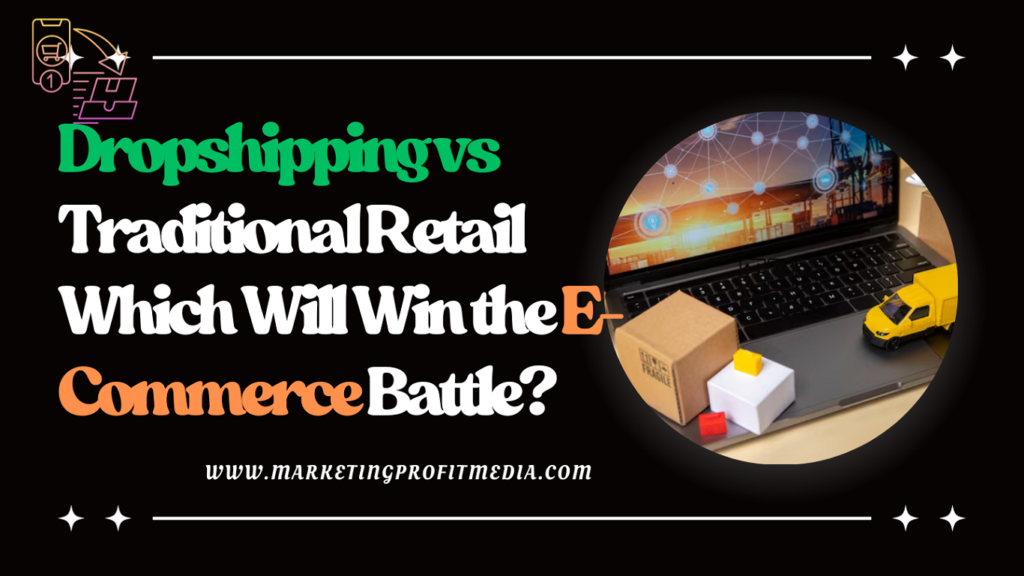In the fast-paced world of e-commerce, two giants battle for supremacy: dropshipping and traditional retail. The battle between these two business models has been ongoing, and each has its unique strengths and weaknesses. In this comprehensive blog post, we’ll delve into the world of dropshipping and traditional retail, comparing them in various aspects to determine which one holds the upper hand. We’ll look at everything from business models to customer experience and sustainability. So, fasten your seatbelts, and let’s dive into this exciting showdown!
My Best Recommended & Proven Way to Make $100 Daily – Watch THIS FREE Training to START >>

What is Dropshipping?
Dropshipping is a modern retail fulfillment method where online stores don’t hold the products they sell in stock. Instead, when a customer makes a purchase, the retailer buys the product from a third-party supplier who then ships it directly to the customer. This eliminates the need for inventory storage and streamlines the supply chain, making it a cost-effective and flexible business model.
The Essence of Traditional Retail
Traditional retail is the conventional approach to selling goods, where businesses purchase products in bulk from wholesalers or manufacturers, store them in physical locations, and then sell them to customers at a markup. This model involves maintaining inventory, in-person interactions with customers, and the use of brick-and-mortar stores. It has a long history and provides a tangible shopping experience for consumers.
The E-Commerce Revolution
E-Commerce Revolution signifies the transformative shift in commerce enabled by the internet. It encompasses the buying and selling of goods and services online, making it accessible to a global audience. This digital era has reshaped business operations, customer behavior, and market dynamics. E-commerce offers convenience, variety, and efficiency, challenging traditional retail models and ushering in a new era of commerce.
Purpose and Scope
The purpose of this blog post is to provide an in-depth exploration of the ongoing battle between dropshipping and traditional retail in the e-commerce landscape. We aim to dissect their advantages, disadvantages, and potential coexistence. By doing so, we help readers understand the complexities of these business models and the evolving nature of e-commerce.
Dropshipping: Pros and Cons
Advantages of Dropshipping
- Low Startup Costs: Dropshipping requires minimal upfront investment, making it accessible for budding entrepreneurs.
- Wide Product Variety: You can easily diversify your product range without stocking inventory.
- Location Independence: Run your business from anywhere with an internet connection.
- Reduced Risk: No unsold inventory gathering dust; only pay for what you sell.
Challenges in Dropshipping
- Thin Profit Margins: Intense competition often leads to lower profit margins.
- Quality Control: You have limited control over product quality and shipping times.
- Inventory Management: Coordinating with multiple suppliers can be challenging.
- Customer Service: Handling customer inquiries and issues can be time-consuming.
Real-Life Example: Success Story
One prime example of dropshipping success is the story of Sarah, a graphic designer turned e-commerce entrepreneur. She started her online store selling customized phone cases using the dropshipping model. With minimal capital, she set up her website, created unique designs, and promoted her products on social media. In just a year, she was making a six-figure income, all without holding any inventory.
Real-Life Example: Failure Story
Conversely, Mark tried his hand at dropshipping but fell victim to poor product quality and slow shipping times. His business crumbled as customers flooded his online store with negative reviews. This demonstrates that while dropshipping offers significant advantages, it’s not a guaranteed path to success.
My Best Recommended & Proven Way to Make $100 Daily – Watch THIS FREE Training to START >>
Traditional Retail: Pros and Cons
Advantages of Traditional Retail
- Full Control: You have complete control over product quality and inventory management.
- In-Person Interaction: Customers can physically interact with products and receive immediate assistance.
- Established Brand: Traditional retail often comes with an established brand presence.
- Local Community Engagement: You can actively participate in the local community.
Challenges in Traditional Retail
- High Overheads: Rent, utilities, and staffing costs can be substantial.
- Limited Market Reach: The customer base is restricted to the local area.
- Inventory Risks: Unsold inventory can lead to significant losses.
- Evolving Consumer Preferences: Adapting to changing trends can be slow and expensive.
Real-Life Example: Success Story
Consider the iconic toy store that has been a cornerstone of a small town for generations. With a loyal customer base and a commitment to the community, it continues to thrive despite the digital age. This demonstrates the enduring value of traditional retail in the right circumstances.
Real-Life Example: Failure Story
Conversely, a small electronics shop struggled as online retailers offered a wider selection and competitive prices. Unable to adapt to the changing landscape, the shop eventually closed its doors, illustrating the unforgiving nature of the market.
The E-Commerce Battle
Market Trends and Statistics
E-commerce has been on an upward trajectory for years. In 2022, global e-commerce sales amounted to $4.9 trillion, and this number is expected to double by 2026. This exponential growth is driving the battle between dropshipping and traditional retail.
Competition Analysis
The competition in the e-commerce arena is fierce. Established retailers are transitioning to online platforms, while new e-commerce startups continue to emerge. Success requires innovative strategies and adaptability.
Strategies for Success
- Omnichannel Approach: Combining online and offline sales channels to reach a broader audience.
- Personalization: Tailoring the shopping experience to individual customer preferences.
- Efficient Logistics: Streamlining the supply chain and delivery processes.
- Sustainable Practices: Embracing eco-friendly initiatives to attract conscious consumers.
A Glimpse into the Future
The future of e-commerce is undoubtedly promising. With advancements in technology like augmented reality and virtual reality shopping experiences, the lines between dropshipping and traditional retail are blurring. It’s likely that the most successful businesses will be those that can adapt to these changes.
Dropshipping and Traditional Retail Symbiosis
Hybrid Business Models
Some businesses are finding success by merging aspects of both dropshipping and traditional retail. They maintain a physical store while also offering online sales with dropshipping capabilities. This hybrid approach allows them to cater to a broader customer base.
Cross-Border Synergies
Traditional retailers are using dropshipping to expand their product offerings, especially in international markets. This allows them to tap into global consumer demand without the need for extensive international warehousing.
Case Study: Combining Forces
A well-known clothing brand integrated dropshipping into their operations to offer customers a wider range of sizes and styles. This approach increased their online sales while maintaining the brand’s in-store presence.
Benefits of Integration
Integrating both models can lead to improved customer satisfaction, increased market reach, and enhanced inventory management. Businesses that successfully combine the two approaches can thrive in the ever-changing e-commerce landscape.
My Best Recommended & Proven Way to Make $100 Daily – Watch THIS FREE Training to START >>
Customer Perspective: What Do They Prefer?
Buyer Behavior in E-Commerce
E-commerce has altered consumer behavior significantly. Shoppers now prefer convenience, a wide selection, and competitive pricing. Understanding these preferences is crucial for success.
The Importance of Customer Experience
A seamless and enjoyable shopping experience is paramount for e-commerce success. Factors like website design, ease of navigation, and responsive customer service play a crucial role.
Testimonials: A Tale of Two Shoppers
- Lisa’s Experience: Lisa enjoys the convenience of online shopping. She appreciates the vast selection and the ability to compare prices easily. Quick deliveries and hassle-free returns have made her a loyal online shopper.
- Tom’s Experience: Tom prefers the in-store experience. He likes to see, touch, and try on products before purchasing. He values the immediate assistance from knowledgeable store staff.
Key Takeaways for E-Commerce Success
To succeed in the e-commerce battle, businesses must strike a balance between the convenience and variety of online shopping and the personalized experience of traditional retail. By understanding and catering to both types of customers, you can position your business for success.
Conclusion
The e-commerce landscape is ever-evolving, and both dropshipping and traditional retail have their places in it. The verdict on who will win the battle is not straightforward. Success in e-commerce will depend on adaptability, customer-centric strategies, and the ability to embrace change.
The Ever-Changing E-Commerce Landscape
As technology advances and consumer preferences shift, the e-commerce landscape will continue to transform. Staying ahead of these changes will be the key to survival and success.
Final Verdict: Who Wins?
In the battle between dropshipping and traditional retail, there might not be a clear winner. Both models have their strengths and weaknesses, and businesses that can adapt and integrate elements of both will likely thrive.
Adapting to the Future
To remain competitive in the ever-changing world of e-commerce, businesses must be ready to embrace new technologies and customer preferences. Whether you’re a dropshipper, a traditional retailer, or a hybrid of both, the future holds opportunities for those who are willing to evolve.
FAQs
1. Which business model is more cost-effective?
- Cost-effectiveness depends on various factors, including the type of products, target market, and business scale. Dropshipping typically has lower upfront costs, while traditional retail may involve higher overheads.
2. Can traditional retailers transition to e-commerce successfully?
- Yes, traditional retailers can transition to e-commerce successfully by embracing online platforms, optimizing their websites, and offering a seamless online shopping experience.
3. How can I start my own e-commerce business?
- To start your own e-commerce business, you need to choose a niche, create a business plan, set up a website, source products, and implement marketing strategies. Research and adapt to market trends.
4. Is dropshipping sustainable in the long run?
- Dropshipping can be sustainable in the long run with careful product selection, reliable suppliers, excellent customer service, and effective marketing strategies. It requires adaptability to changing market dynamics.
5. What’s the role of social media in e-commerce?
- Social media plays a significant role in e-commerce by providing a platform for marketing, customer engagement, and product promotion. It’s a valuable tool for reaching and interacting with a broader audience.
My Best Recommended & Proven Way to Make $100 Daily – Watch THIS FREE Training to START >>
Thanks for reading my article on “Dropshipping vs. Traditional Retail Which Will Win the E-Commerce Battle?“, hope it will help!














